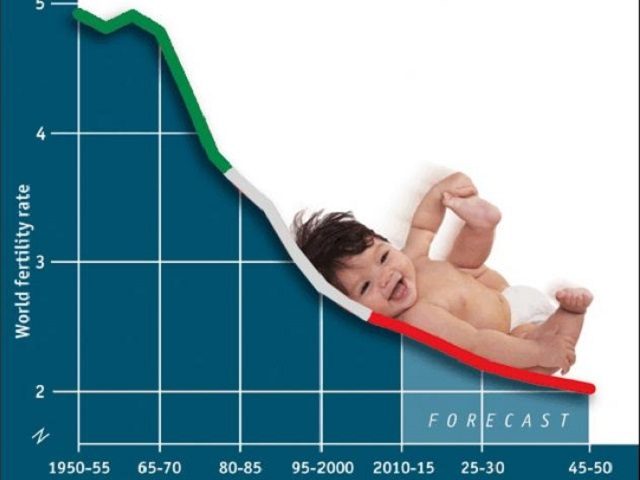The Italian Statistics Bureau (ISTAT) has released demographic forecasts for the country predicting a steadily declining population due to a birthrate well below replacement levels.
From 60.6 million in 2017, Italy’s population is expected to fall by more than ten percent over the next several decades to just 54.1 million in 2065, ISTAT stated in its May 2018 report. This drop will occur despite increased life expectancy, which is projected to grow by 5 years for both genders, reaching 86.1 years and 90.2 years, respectively for men and women (80.6 and 85 years in 2016), ISTAT said.
The fertility rate in Italy is currently 1.34 children per woman, significantly below the replacement level of roughly 2.1 children per woman. Globally, Italy is ranked 212 out of 223 countries for new live births as a percentage of the total population, with just 8.6 live births per 1000 citizens.
Since Italians are having fewer and fewer babies, the only thing holding keeping the population from more severe decline is immigration, which means as a consequence that Italy is becoming less and less Italian.
As Breitbart News reported last July, Italy’s low birthrate combined with increased immigration indicates that native Italians will make up an increasingly small percentage of Italy’s overall population.
Italy’s fertility rate is less than half of what it was in 1964, the Centro Machiavelli reported in a study titled “How immigration is changing Italian demographics.” The birthrate has dropped from 2.7 children per woman to just 1.5 children per woman.
In 2017, Italy had over five million foreigners living as residents, a striking growth of 25 percent relative to 2012 and a remarkable 270 percent over 2002, when foreigners made up just 2.38 percent of the population.
Even the children currently being born in Italy are over-represented by immigrants, whose birthrate is considerably higher than native Italians, the study found. It is “unsurprising,” therefore, that Italian regions with the highest fertility rates are no longer in the south, as was ever the case, but in the Italian north and in the Lazio region, where there is a higher concentration of immigrants, it said.
Italy’s falling birthrate also endangers the nation’s economic future, since a shrinking (and aging) population means that fewer workers will be paying taxes to fund the government pensions of the nation’s retirees.
Future births will not be sufficient to compensate for deaths, the report declares, and the birth rate is expected to decline by 300,000 and 400,000 in the medium-term and long-term future.
A third factor influencing Italy’s demographic shift is increasing emigration, especially of younger generations who, discouraged by Italy’s economic and unemployment woes, are leaving the country to seek their fortune elsewhere.
Leaders of the Catholic Church in Italy have expressed their concern over Italy high rate of emigration, and in 2016 the President of the Italian Bishops Conference (CEI) decried the exodus of Italy’s best and brightest, warning that the loss of talented Italian citizens was “depleting” the country.
At the time, Cardinal Angelo Bagnasco linked the high levels of Italian emigration to an ongoing economic crisis that had dried up the jobs market and left many Italians in dire financial straits. Unfortunately, since then the crisis has only grown worse.
“The official figures speak for themselves,” Bagnasco said, noting Italy’s grim economic statistics.
“New contracts have decreased by 12.1 percent, GDP is not growing, unemployment among those aged 15 to 24 years has risen to 39.2 percent and industrial production has diminished by 0.8 percent,” he said at the time.
The Cardinal also noted that the worst fallout from the crisis may well be a drain on Italy’s most precious resource: its citizens, and especially the young.
“We are deeply concerned that the patrimony of skillfulness and ingenuity of our people is being forced to emigrate, thus impoverishing the country,” he said.
Follow Thomas D. Williams on Twitter Follow @tdwilliamsrome

COMMENTS
Please let us know if you're having issues with commenting.